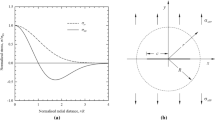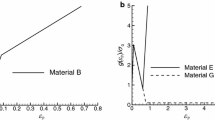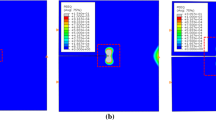Abstract
The influence of crack closure and elasto-plastic flow on the bending behavior of thin cracked plates is investigated through use of an incremental elasto-plastic plate bending finite element computer program. The finite element program was developed using assumptions consistent with Kirchhoff fourth order plate theory while the material property treatment permits general isotropic work hardening with local elastic unloading.
This technique is applied to the problem of a large centrally through cracked plate subject to remote circular bending. Comparison is drawn between two cases of the bending problem. The first neglects the possibility of crack face interference with bending, and the second includes a kinematic prohibition against the crack face from passing through the symmetry plane. Results are reported which isolate the effects of elasto-plastic flow and crack closure.
Résumé
L'influence de la fermeture de la fissure et de l'écoulement élastoplastique sur le comportement à la flexion de tôles minces fissurées, est étudiée en faisant appel à un programme de calcul par éléments finis de la flexion incrémentielle de la tôle en régime élastoplastique. Le programme d'éléments finis a été développé en recourant à des hypothèses satisfaisant la théorie des plaques du quatrième ordre de Kirchhoff; les propriétés mécaniques considérées pour le matériau permettent, par ailleurs, de considérer un écrouissage général isotrope, avec réactions élastiques locales lors du déchargement.
Cette technique a été appliquée au problème d'une grande tôle circulaire traversée en son centre par une fissure et soumise à flexion pure en son pourtour. On établit la comparaison de deux cas types du problème de flexion: le premier, où l'on néglige la possibilité d'interférence des faces de la fissure avec le moment de flexion, et le second, où l'on introduit un obstacle cinématique au passage de la fissure au travers du plan de symétrie.
Les résultats rapportés isolent les effets de l'écoulement élastoplastique et de la fermeture de la fissure.
Similar content being viewed by others
References
M. L. Williams, Journal of Applied Mechanics, 28, 1 (1961) 78–82.
M. L. Williams and D. D. Ang, Journal of Applied Mechanics, 28, 3 (1961) 372–378.
J. K. Knowles and N. K. Wang, Journal of Mathematics and Physics, 39 (1960) 223–236.
J. L. Swedlow, M. L. Williams and W. H. Yang, Elasto-Plastic Stresses and Strains in Cracked Plates, Proceedings of the First International Conference on Fracture, 1 (1965) 259–282.
R. H. Wynn and C. W. Smith, Journal of Basic Engineering, Trans. ASME, 91 (1969) 841–849.
D. P. Jones, Elasto-Plastic Bending of Cracked Plates, Including the Effects of Crack Closure, Ph.D. Thesis, Carnegie-Mellon University, WAPD-T-2539, October 1972.
J. L. Swedlow, Int. J. Non-Linear Mechanics, 3 (1968) 325–336.
F. S. Beckman, The Solution of Linear Equations by the Conjugate Gradient Method, Mathematical Methods for Digital Computers, A. Ralston and H. S. Wilf (Eds.), Wiley (1960) 62–72.
H. F. Brinson and H. Gonzalez, Experimental Mechanics, 12 (1972) 130–134.
Author information
Authors and Affiliations
Rights and permissions
About this article
Cite this article
Jones, D.P., Swedlow, J.L. The influence of crack closure and elasto-plastic flow on the bending of a cracked plate. Int J Fract 11, 897–914 (1975). https://doi.org/10.1007/BF00033836
Received:
Revised:
Issue Date:
DOI: https://doi.org/10.1007/BF00033836




